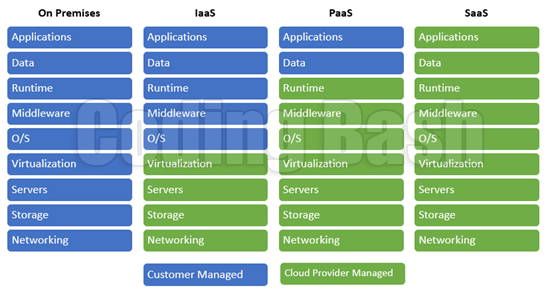 Azure
Azure
PaaS vs SaaS vs IaaS
In this article, we will learn about the PaaS, SaaS & IaaS service model of the cloud.
Total Views: 2147
As we know that cloud computing is divided into three service models i.e., SaaS (Software as a Service), PaaS (Platform as a Service), and IaaS (Infrastructure as a Service).
1. SaaS (Software as a Service): In the SaaS model, software that is hosted and managed by the Cloud Provider is provided to the end-user. It comes with a multitenant architecture means a single version of the application is provided to all customers. One of the examples of SaaS is Microsoft 365 (provides Exchange Service, Storage Service (One Drive), Microsoft Office suite, etc.) in which user needs to pay the Monthly or Annual Subscription charges to the cloud providers. Rather than paying for the perpetual license for Office, the user pays only for Monthly or Annual Subscriptions. In the SaaS model, users can access the software through the web interface. As in Microsoft 365, the user can access Word, Excel, and other office applications through a web browser as well as it gives the capability to install it on his device locally. Dropbox is another example of SaaS.
2. PaaS (Platform as a Service): PaaS is a combination of SaaS and IaaS in which a Cloud Provider like Microsoft provides and manages the virtualized infrastructure as well as provides the software to facilitate the application development. Azure provides Azure Websites, Azure Cloud Services (web and worker roles). Instead of setting up the Virtual Machine, networks, installing the software on them so that the application can be run on it, developers can directly publish code there without worrying about the infrastructure management. For example, A user wants an ASP.NET web application. With PaaS, the User doesn't need to worry about setting up the server, installing up .Net Framework and other software required to run the application. Instead of it, user can directly focus on the development of the web application.
3. IaaS (Infrastructure as a Service): In IaaS, a Cloud provider runs and manages the server farms with the use of virtualization software. On the other end, Users can create VMs that run on the Cloud provider’s infrastructure. With Microsoft Azure, you can run Windows, Linux, or any other OS, etc. on the VMs and also provides the ability to set up virtual networks, load balancers, storage, etc. on their infrastructure. For example, you are working on a project which required multiple Application Server, multiple SQL Server databases. In that case, IaaS can be cost-effective as you only need to pay for the operational cost. Scalability is another important aspect of the IaaS model. You can easily scale up or scale out the resources whenever required. In IaaS, Microsoft manages the hardware whereas the user is responsible for managing Virtual Machines, operating systems, and applications running in the Virtual Machine.
In the below image, you can see the different levels of shared responsibility of the Cloud Provider and Customer in On-Premises, IaaS, PaaS, and SaaS service models.

